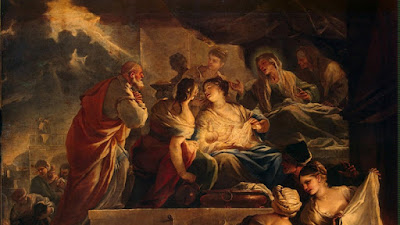Today in some places is kept the feastday of St. Veronica of Giuliani. The following account of her holy life is taken from
The Franciscan Book of Saints, ed. by Marion Habig, OFM
Saint Veronica Giuliani was born of devout parents at Mercatello in Italy. As a child she, too, was of a devout disposition, but inclined to be quite irritable, and, as she herself admits, would stamp her feet at the least provocation.
Saint Veronica's mother died when Veronica was only four years old. In her last moments she assigned each of her five children to one of the five wounds of Christ and bade them take their refuge there whenever they were troubled. Veronica was the youngest. She was assigned to the wound in the side of our Lord, and from that time on her heart became more tempered.
Co-operating with the grace of God, her soul gradually went through a refining process by which she became an object of admiration in later years.
When Saint Veronica came of age, her father believed she should marry, and so he desired her to take part in the social activities of the young people. But she had been made aware of another call, and she pleaded so earnestly with her father that, after much resistance, he finally permitted her to choose her own state in life.
At the age of 17, then, the Saint Veronica Giuliani entered the convent of the Capuchin nuns at Citta di Castello in Umbria, where the primitive rule of St Clare was observed. Imbued with sincere humility she considered herself the lowliest member of the community. At the same time she greatly edified all by her obedience and love of poverty and mortification. Sometimes she was favored with interior conversations and revelations. She resolved that she would reveal all such matters to her superiors and her confessor; she had neglected to do that when she was still in the world, and as a result she had often been misled by the father of lies.
When Saint Veronica Giuliani had spent 17 years in various offices in her community, she was entrusted with the guidance of the novices. She endeavored to imbue them with the spirit of simplicity and to lay a firm foundation for humility. She directed them to the truths of the Faith and the rules of the order as their safest guides on the way of perfection, and warned them against reading idly speculative books as well as against everything unusual.
Meanwhile, extraordinary things were beginning to happen to Saint Veronica Giuliani. On Good Friday she received the stigmata, and later the Crown of Thorns was impressed on her head amid untold sufferings. She also experienced a mystical espousal, as she was given a mystical ring by Our Lord's own hand. One eye-witness said: "This ring encircled her ring finger as ordinary rings do. On it there appeared to be a raised stone as large as a pea and of a red color."
After careful examination of the matters, the bishop sent a report to Rome. Then Rome appointed a commission, which was to put her humility to the severest test, in order to determine whether she was an imposter, a person deluded by the devil, or a person favored by God.
Saint Veronica Giuliani was deposed from her office as novice mistress, and deprived of every suffrage in the community. She was even imprisoned in a remote cell. No sisters were permitted to talk to her, and a lay sister who was made her warden was ordered to treat her like a deceiver. Finally, she was even deprived of Holy Communion and was permitted to attend holy Mass only on Sundays and holy days near the door of the church.
At the conclusion of these trials, the bishop reported to Rome that she scrupulously obeyed every one of his ordinances, and showed not the least sign of sadness amid all his harsh treatment, but rather an inexpressible peace and joy of spirit.
The test had proved the admirable manifestations to be the work of God, but Veronica did not on that account deem herself a saint, but rather a great sinner, whom God was leading on the way to conversion by means of His holy wounds.
Having filled the office of novice mistress during a space of 22 years, Veronica was unanimously elected abbess. Only in obedience could she be prevailed upon to accept the responsibility.
Purified more and more by many sufferings, to which she added many austere mortifications, she went to her eternal reward on July 9, 1727, after spending 50 years in the convent.
Saint Veronica Giuliani was one of the rare saints who had received the stigmata. Whenever the wounds were opened, Fr. Salvatori recorded that "they emitted so delicious a fragrance throughout the whole of the convent that this alone was sufficient to inform the nuns whenever the stigmata had been renewed."
The saint's body remained incorrupt for many years until it was destroyed in a flood. Her bones are now kept in a composite figure of the saint, the skull of which is covered with wax. Her heart, though, is still incorrupt, and is kept in a separate reliquary.
Because of her heroic virtues and the many miracles that were continually being worked at her tomb, she was canonized by Pope Gregory XVI in 1839.
Collect:
Lord Jesus Christ, who didst miraculously imprint the marks of thy own suffering upon the blessed maid Veronica, grant in thy loving kindness that, by crucifying the flesh, we may become worthy to gain everlasting joys: thou who art God.

















